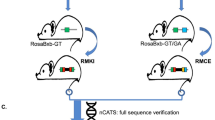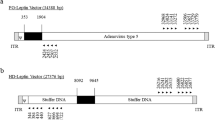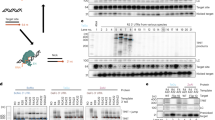Abstract
The recent completion of the human genome sequence1 allows genomics research to focus on understanding gene complexity, expression, and regulation. However, the routine-use genomic DNA expression systems required to investigate these phenomena are not well developed. Bacterial artificial chromosomes (BACs) and P1-based artificial chromosomes (PACs) have proved excellent tools for the human genome sequencing projects. We describe a system to rapidly and efficiently deliver and express BAC and PAC library clones in human and mouse cells by converting them into infectious amplicon vectors. We show packaging and intact delivery of genomic inserts of >100 kilobases with efficiencies of up to 100%. To demonstrate that genomic loci transferred in this way are functional, the complete human hypoxanthine phosphoribosyltransferase (HPRT) locus contained within a 115-kilobase BAC insert was shown to be expressed when delivered by infection into both a human HPRT-deficient fibroblast cell line and a mouse primary hepatocyte culture derived from Hprt−/− mice. Efficient gene delivery to primary cells is especially important, as these cells cannot be expanded using antibiotic selection. This work is the first demonstration of infectious delivery and expression of genomic DNA sequences of >100 kilobases, a technique that may prove useful for analyzing gene expression from the human genome.
This is a preview of subscription content, access via your institution
Access options
Subscribe to this journal
Receive 12 print issues and online access
$209.00 per year
only $17.42 per issue
Buy this article
- Purchase on Springer Link
- Instant access to full article PDF
Prices may be subject to local taxes which are calculated during checkout




Similar content being viewed by others
References
The International Human Genome Sequencing Consortium. Initial sequencing and analysis of the human genome. Nature 409, 860–921 (2001).
Peltonen, L. & McKusick, V.A. Dissecting human disease in the postgenomic era. Science 291, 1224–1229 (2001).
The International Human Genome Mapping Consortium. A physical map of the human genome. Nature 409, 934–941 (2001).
Simon, M.I. Dysfunctional genomics: BACs to the rescue. Nat. Biotechnol. 15, 839 (1997).
Yang, X.W., Model, P. & Heintz, N. Homologous recombination-based modification in Escherichia coli and germline transmission in transgenic mice of a bacterial artificial chromosome. Nat. Biotechnol. 15, 859–865 (1997).
Wade-Martins, R., White, R.E., Kimura, H., Cook, P. & James, M.R. Stable correction of a genetic deficiency in human cells by an episome carrying a 115 kb genomic transgene. Nat. Biotechnol. 18, 1311–1314 (2000).
Yang, X.W., Wynder, C., Doughty, M.L. & Heintz, N. BAC-mediated gene-dosage analysis reveals a role for Zipro1 (Ru49/Zfp38) in progenitor cell proliferation in cerebellum and skin. Nat. Genet. 22, 327–335 (1999).
Schiedner, G., et al. Genomic DNA transfer with a high-capacity adenovirus vector results in improved in vivo gene expression and decreased toxicity. Nat. Genet. 18, 180–183 (1998).
Spaete, R.R. & Frenkel, N. The herpes simplex virus amplicon: a new eucaryotic defective-virus cloning-amplifying vector. Cell 30, 295–304 (1982).
Geller, A.I. & Breakefield, X.O. A defective HSV-1 vector expresses Escherichia coli β-galactosidase in cultured peripheral neurons. Science 241, 1667–1669 (1988).
Saeki, Y., Fraefel, C., Ichikawa, T., Breakefield, X.O. & Chiocca, E.A. Improved helper virus-free packaging system for HSV amplicon vectors using an ICP27-deleted, oversized HSV-1 DNA in a bacterial artificial chromosome. Mol. Ther. 3, 591–601 (2001).
Shizuya, H., et al. Cloning and stable maintenance of 300-kilobase-pair fragments of human DNA in Escherichia coli using an F-factor based vector. Proc. Natl. Acad. Sci. USA 89, 8794–8797 (1992).
Ioannou, P.A. et al. A new bacteriophage P1-derived vector for the propagation of large human DNA fragments. Nat. Genet. 6, 84–89 (1994).
Wang, S. & Vos, J.-M.H. A hybrid herpesvirus infectious vector based on Epstein–Barr virus and herpes simplex virus type 1 for gene transfer into human cells in vitro and in vivo. J. Virol. 70, 8422–8430 (1996).
Caskey, C.T. & Kruh, G.D. The HPRT locus. Cell 16, 1–9 (1979).
Hooper, M., Hardy, K., Handyside, A., Hunter, S. & Monk, M. HPRT-deficient (Lesch–Nyhan) mouse embryos derived from germline colonisation by cultured cells. Nature 326, 292–295 (1987).
Wade-Martins, R., Frampton, J. & James, M.R. Long-term stability of large insert genomic DNA episomal shuttle vectors in human cells. Nucleic Acids Res. 27, 1674–1682 (1999).
Ziauddin, J. & Sabatini, D.M. Microarrays of cells expressing defined cDNAs. Nature 411, 107–110 (2001).
Horikawa, Y. et al. Genetic variation in the gene encoding calpain-10 is associated with type2 diabetes mellitus. Nat. Genet. 26, 163–175 (2000).
Schindelhauer, D. & Cooke, H.J. Efficient combination of large DNA in vitro: in gel site-specific recombination (IGSSR) of PAC fragments containing α satellite DNA and the human HPRT gene locus. Nucleic Acids Res. 25, 2241–2243 (1997).
Acknowledgements
This work was supported by NIH Grant (CA692460) and a Wellcome Trust grant to E.A.C. R.W-M. is a Wellcome Trust International Prize Travelling Research Fellow and E.R.S. is a Pete Gilmore/American Brain Tumour Association Fellow. We would like to thank Dr. John Mullen for his help in establishing hepatocyte cultures, and Drs. Cornel Fraefel, Xandra Breakefield, Michael James, Peter Cook, and Hiroshi Kimura for helpful discussion and advice.
Author information
Authors and Affiliations
Corresponding author
Rights and permissions
About this article
Cite this article
Wade-Martins, R., Smith, E., Tyminski, E. et al. An infectious transfer and expression system for genomic DNA loci in human and mouse cells. Nat Biotechnol 19, 1067–1070 (2001). https://doi.org/10.1038/nbt1101-1067
Received:
Accepted:
Issue Date:
DOI: https://doi.org/10.1038/nbt1101-1067
This article is cited by
-
A novel cocktail therapy based on quintuplet combination of oncolytic herpes simplex virus-2 vectors armed with interleukin-12, interleukin-15, GM-CSF, PD1v, and IL-7 × CCL19 results in enhanced antitumor efficacy
Virology Journal (2022)
-
The infectious BAC genomic DNA expression library: a high capacity vector system for functional genomics
Scientific Reports (2016)
-
Developing de novo human artificial chromosomes in embryonic stem cells using HSV-1 amplicon technology
Chromosome Research (2015)
-
Comparative study of artificial chromosome centromeres in human and murine cells
European Journal of Human Genetics (2013)
-
Infectious delivery and long-term persistence of transgene expression in the brain by a 135-kb iBAC-FXN genomic DNA expression vector
Gene Therapy (2011)



